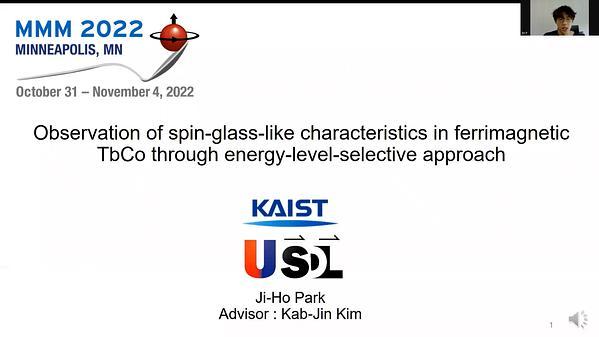Would you like to see your presentation here, made available to a global audience of researchers?
Add your own presentation or have us affordably record your next conference.
Rare-earth iron garnets, a ferrimagnetic insulator, have received attention for their many properties including small damping and tunable magnetization and angular momentum compensation temperatures. Most research efforts have been focused on garnet thin films grown on the (111) plane because of their perpendicular magnetic anisotropy (PMA), and the in-plane anisotropy, however neglected, can be important for our understanding of the switching behavior and the energetics of magnetic textures. In-plane anisotropy can be conveniently explored in garnet thin films on (110) planes. Here we combine a theoretical and experimental analysis of the anisotropy landscape for Europium iron garnet (EuIG) epitaxially grown on (110) Gadolinium Gallium garnet (GGG) using pulsed laser deposition.
The angular dependence of anisotropy is calculated by combining the individual contributions including magnetocrystalline anisotropy, magnetoelastic anisotropy, shape anisotropy and growth-induced anisotropy, which may contribute for non-ideal stoichiometry. This predicts an easy axis out of plane along 110, with hard and intermediate axes in plane along 001 and 1-10 respectively. The anisotropy landscape is probed with vibrating sample magnetometry (VSM) and spin-Hall magnetoresistance (SMR) measurements. The SMR result is simulated and fitted to a Stoner-Wohlfarth model. The experimental measurements yield the expected hard and easy axes but the model requires additional multi-domain consideration to capture the hysteresis behavior when the external field is swept along the intermediate in-plane axis. Understanding the in-plane anisotropy effect, especially the unexpected hysteresis in in-plane direction for a PMA film could have help with the interpretation of the switching behavior.
References:

Fig. 1 (a) VSM measurement along the in-plane easy (IP 35, 1-10), in-plane hard (-55, 001) and out-of-plane (OP, 110) axes. (b) Left: Principal anisotropy axis definition in EuIG and setup for Stoner Wohlfarth simulation. Right: 3D polar plot for anisotropy landscape in EuIG. (c) SMR measurement for field swept along the hard anisotropy axis, with fit (red). (d) SMR measurement for field swept along the intermediate anisotropy axis.
